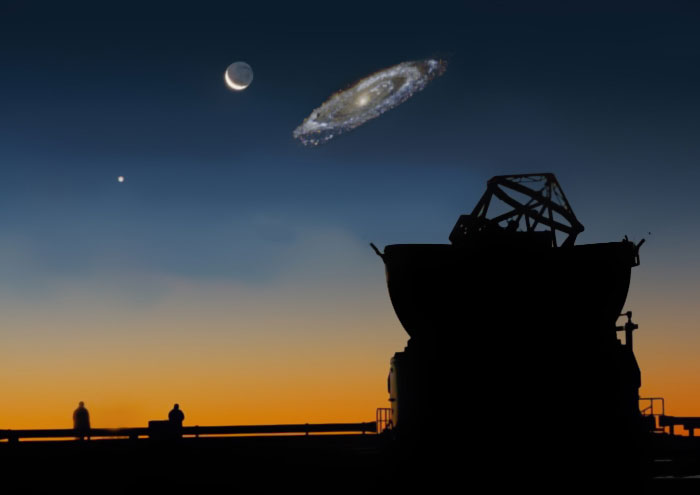Challenge 8 – Exploring Angular Diameter
Angular size is a property of observing an object with a fixed diameter at different distances. The farther away the object is, the smaller it appears to be. This is why you can cover a distant mountain that is 2 miles high with a dime held at arms-length.
In astronomy, all of the objects you see in the sky can only be compared by their angular size as measured from where you are standing. Without knowing their distances, you cannot tell if they are small, close-by objects, or distant, huge objects. Here is an extreme example.
Moon and Andromeda galaxy composite
Credit: Sten Odenwald NASA/HEC, Paranal Observatory/ESO and NASA/GALEX
This is a composite of two images to the same angular scale. The Andromeda galaxy is located over 2 million light years from Earth and was imaged by NASA’s GALEX satellite and added to an image of the crescent moon at sunset from ESO’s Paranal Observatory in Chile. From the surface of Earth, the diameter of our moon is about ½ a degree and the Andromeda galaxy is about 3 degrees across. In fact, because of the enormous difference in actual size and distance, the moon, which is only about 3,400 km in diameter and the Andromeda Galaxy, which is over 100,000 light years in diameter, seem comparable in size!
We have total solar eclipses visible on the surface of Earth because even though the diameter of the sun is 1,392,600 km and the diameter of the moon is 3,474 km, the vast difference in their distance allow their angular diameters to be nearly the same or about ½ a degree. We can use a simple proportion to work out the details. The angle in degrees that an object of a given diameter and distance subtends is given by the ‘skinny triangle’ formula:
Usually, astronomical objects appear to be much smaller than one degree, so because there are 3600 arcseconds in one degree, this can be converted into an angular measure in arcseconds:
Problem 1 – At the time of the August 21, 2017 eclipse, the sun is located 151,384,000 km from the center of Earth. What is its angular diameter?
Problem 2 – At the time of the August 21, 2017 eclipse, the moon is located 365,600 km from the surface of Earth. What is its angular diameter?
Problem 3 – The vertex of the moon’s shadow cone is located 377,700 km from the center of the moon, and about 700 km below the surface of Earth. If you were standing there, what would be the angular diameter of the moon?








